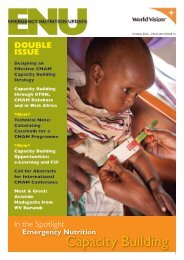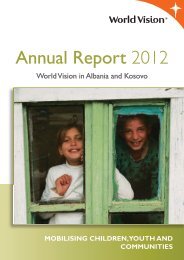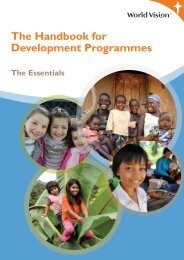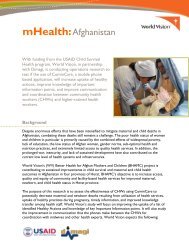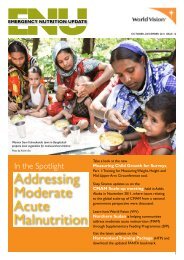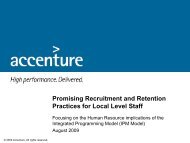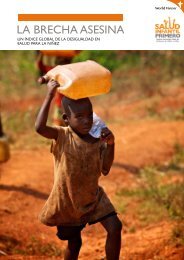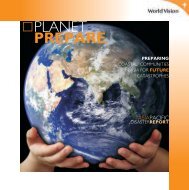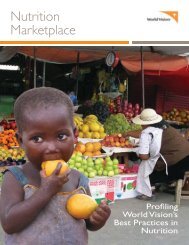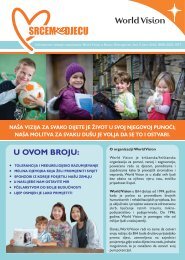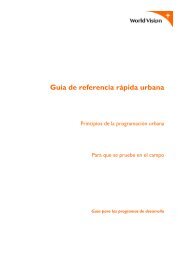• disability is a personal problem• traditional ways of understanding disability, focus on <strong>the</strong> person’s injury and handicaps that resultfrom it• this model attempts <strong>to</strong> “cure” or “improve” <strong>the</strong> individual, so that he “fits in society”• it defines a person <strong>with</strong> <strong>disabilities</strong> , only as a patient <strong>with</strong> medical needs• it separates <strong>the</strong> person <strong>with</strong> <strong>disabilities</strong> from possibilities of inclusion• provides only medical help from specialists• it is costly and its benefits appear <strong>to</strong> be relatively smallsocial Model regards disability as a problem created by society and does not attribute it <strong>to</strong> <strong>the</strong> individual.Under <strong>the</strong> social model, disability demands addressing through social policy, since <strong>the</strong> problem was createdas a result of an inadequate physical environment created by attitudes and o<strong>the</strong>r characteristics of <strong>the</strong> socialenvironment. It focuses on <strong>the</strong> barriers that exist in <strong>the</strong> view of society <strong>to</strong>wards people <strong>with</strong> <strong>disabilities</strong>.According <strong>to</strong> this model, <strong>the</strong> activities focus on involving persons <strong>with</strong> <strong>disabilities</strong> <strong>to</strong> be seen as part ofsociety. Considered from this perspective:• disability focuses on society, not in people <strong>with</strong> <strong>disabilities</strong> as <strong>the</strong>ir problem• people are <strong>with</strong> <strong>disabilities</strong>, because society denies <strong>the</strong>ir <strong>right</strong>s and opportunities• it views disability as a social reflection on person’s impairment• according <strong>to</strong> this model, <strong>the</strong> <strong>right</strong>s and needs of persons <strong>with</strong> <strong>disabilities</strong> are <strong>the</strong> same <strong>with</strong> thoseof persons <strong>with</strong>out <strong>disabilities</strong> - e.g. <strong>education</strong>, health care, employment• activities focus on identifying and eliminating environmental and institutional barriers as well asattitudes, which do not give way <strong>to</strong> inclusionBy analyzing both <strong>the</strong>se models separately, <strong>the</strong>y may be regarded as insufficient, although both are partiallyvalid. Disability is a complex phenomenon, it is always an interaction between individual characteristics and<strong>the</strong> context in general where <strong>the</strong> individual lives, but some aspects of it are entirely internal, personal, andat times outer. In o<strong>the</strong>r words, <strong>the</strong> two models, <strong>the</strong> first from <strong>the</strong> medical perspective and <strong>the</strong> second fromsocial perspective, have <strong>the</strong>ir significance if applied in conjunction <strong>with</strong> each - o<strong>the</strong>r. They are convenient interms of problems related <strong>to</strong> disability and nei<strong>the</strong>r one should be disregarded.a better model <strong>to</strong> address disability, is that model which syn<strong>the</strong>sizes what is true in <strong>the</strong> medicaland social models, <strong>with</strong>out falling in<strong>to</strong> <strong>the</strong> common mistake in reducing <strong>the</strong> notion of full and complexdisability <strong>to</strong> a problem of <strong>the</strong> person. This model, most useful <strong>for</strong> disability is called <strong>the</strong> “biopsychologymodel”. It promotes <strong>the</strong> idea that <strong>the</strong> physical, psychological and social environmental conditions, tend <strong>to</strong>influence one ano<strong>the</strong>r and should be taken in<strong>to</strong> consideration in order <strong>to</strong> understand and help individuals<strong>with</strong> <strong>disabilities</strong>. The biopsychology model is adjusted <strong>to</strong> environmental causes, and social effects <strong>the</strong>y bring<strong>to</strong> individuals <strong>with</strong> <strong>disabilities</strong>.14 The <strong>right</strong> <strong>to</strong> Inclusive Education <strong>for</strong> <strong>children</strong> <strong>with</strong> Disabilities
2. chaPTer TwoDisabled <strong>children</strong>’s <strong>education</strong> situation over <strong>the</strong> years. An his<strong>to</strong>ric and reflecting overview2.1. disabled <strong>children</strong>’s <strong>education</strong> situation in 1944 – 1990The provision of services <strong>for</strong> persons <strong>with</strong> <strong>disabilities</strong> in Albania, began in <strong>the</strong> early years after <strong>the</strong>establishment of Enver Hoxha’s communist regime, thus paving <strong>the</strong> way <strong>for</strong> <strong>the</strong> developments in special<strong>education</strong> in <strong>the</strong> following years. Orientation of <strong>the</strong>se services was mainly <strong>to</strong>ward <strong>the</strong> care <strong>for</strong> daily needs ofindividuals <strong>with</strong> <strong>disabilities</strong>, providing shelter and nutrition, usually assisting <strong>the</strong>m through an institutionalizedstructure, <strong>with</strong>out any ef<strong>for</strong>ts <strong>to</strong>ward <strong>the</strong>ir rehabilitation and integration. These individuals were considered<strong>to</strong>tally dependent and incompetent, thus arousing feelings of pity and mercy <strong>for</strong> <strong>the</strong>m. They were lookedupon as disabled, whose <strong>education</strong>al treatment was not a primary consideration <strong>for</strong> state and society.As in many o<strong>the</strong>r European countries, even in Albania <strong>the</strong> care <strong>for</strong> <strong>children</strong> and youth <strong>with</strong> <strong>disabilities</strong>, isdeveloped outside <strong>the</strong> <strong>education</strong> system and traditionally over a long period of time, <strong>the</strong>y have been lef<strong>to</strong>utside of this system. Disability was treated as a disease and <strong>the</strong>re was no o<strong>the</strong>r <strong>for</strong>m of treatment <strong>for</strong> it.It is hard <strong>to</strong> define an exact date in <strong>the</strong> his<strong>to</strong>ry of special development that would mark its beginnings. Nodoubt that in different time periods and different society development stages, <strong>the</strong>re have been <strong>for</strong>mal andin<strong>for</strong>mal adjustments in <strong>the</strong> practices and ways <strong>to</strong> help and support disabled persons through <strong>the</strong> years(from 1945 onward). As in many o<strong>the</strong>r countries so also in Albania, special <strong>education</strong> has its developmenthis<strong>to</strong>ry. If we refer <strong>to</strong> <strong>the</strong> his<strong>to</strong>ry of Greek special <strong>education</strong>, we can ascertain that: <strong>the</strong> first steps <strong>to</strong>secure special services were taken from humanitarian organizations or churches. Ef<strong>for</strong>ts in <strong>the</strong> area ofproviding special <strong>education</strong> services were dominated by private organizations, while <strong>the</strong> public sec<strong>to</strong>r wasminimally involved at least <strong>to</strong> <strong>the</strong> 70s. From 1972, <strong>the</strong> year when <strong>the</strong> first legislation on special <strong>education</strong>was introduced, until 1985, all legislative actions have taken place outside <strong>the</strong> mainstream <strong>education</strong> law(Stasinos, 1991). Special <strong>education</strong> structures were developed outside <strong>the</strong> Ministry of Education, while <strong>the</strong>management, organizational structures, and inspection were controlled by <strong>the</strong> o<strong>the</strong>r Ministries.In France <strong>the</strong> beginnings of care and special <strong>education</strong> <strong>for</strong>ms <strong>for</strong> individuals <strong>with</strong> <strong>disabilities</strong>, date very early.1793 is considered a symbolic date of rehabilitation re<strong>for</strong>ms’ starting point in terms of this category ofindividuals. It is <strong>the</strong> year when Doc<strong>to</strong>r Philippe Pinel received permission from Paris Commune <strong>to</strong> free89 “crazed people” from shackles. Up <strong>to</strong> that time “<strong>the</strong> crazed” were housed <strong>with</strong> <strong>the</strong> convicts and <strong>the</strong>criminals. For <strong>the</strong> first time <strong>the</strong>y were called “sick” that deserved treatment and care and this change inattitude marked <strong>the</strong> emerging of <strong>the</strong> modern psychiatry, which would spread in Europe (Bouissou, 1967). Asecond development in <strong>the</strong> his<strong>to</strong>ry of special <strong>education</strong> in France was <strong>the</strong> opening of schools <strong>for</strong> deaf andblind <strong>children</strong> in <strong>the</strong> eighteenth century. These services were often provided by religious institutions. Duringthis period Abbe de I’epee opened a school <strong>for</strong> deaf and mute and Valentin Hauy opened an institution <strong>for</strong>blind <strong>children</strong> during this period. O<strong>the</strong>r similar institutions were opened in <strong>the</strong> following years. Towards <strong>the</strong>end of <strong>the</strong> nineteenth century, <strong>the</strong>re was a rise of interest in <strong>the</strong> fields of psychology and psychoanalysis.In 1909 a law was enacted which made possible <strong>the</strong> opening through local initiatives of “improvementclasses” <strong>for</strong> <strong>children</strong> <strong>with</strong> learning <strong>disabilities</strong>.In Albania, after an analysis and scrutiny of available evidence on <strong>the</strong> main strengths and characteristics ofdocumented special <strong>education</strong>, <strong>the</strong>re can be identified three distinct chronological phases in <strong>the</strong> special<strong>education</strong> his<strong>to</strong>ry through <strong>the</strong> years:The <strong>right</strong> <strong>to</strong> Inclusive Education <strong>for</strong> <strong>children</strong> <strong>with</strong> Disabilities15



